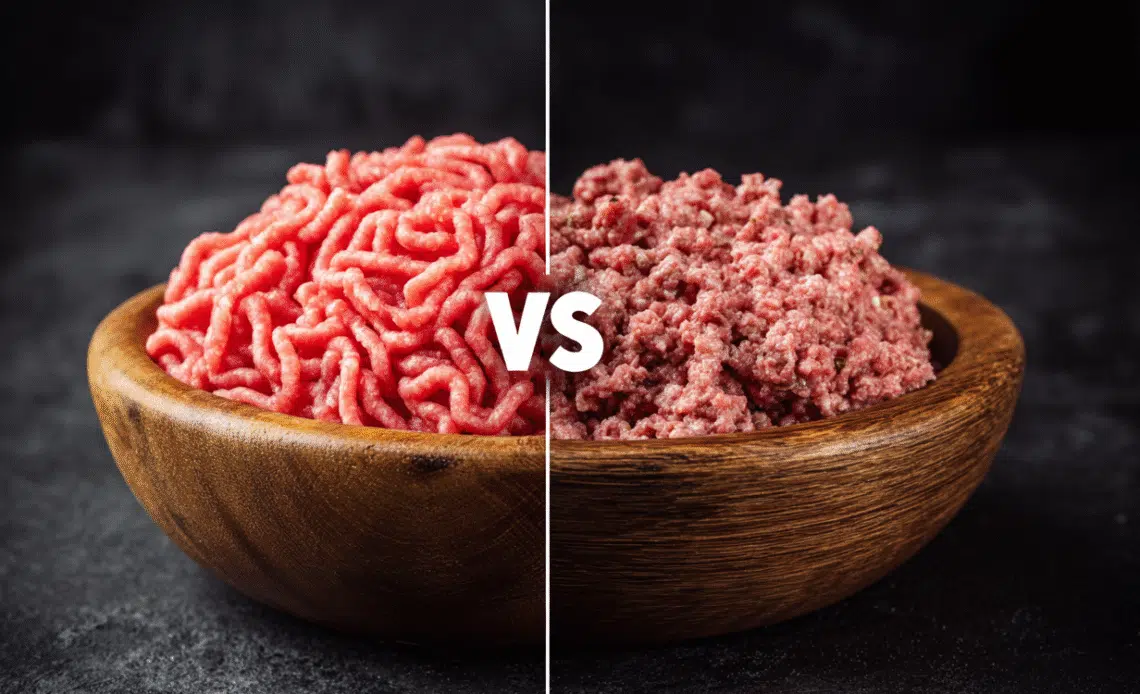Ground Turkey vs Ground Beef: Which Is Healthier? Here’s What a Dietitian Says is a question many health-conscious individuals ponder as they navigate their dietary choices. With increasing awareness of nutrition and overall health, understanding the differences between these two popular meats can help guide your decisions in the kitchen. In this article, we’ll explore what makes each option unique, their nutritional profiles, and which one might be the better choice for you.

Nutritional Profiles of Ground Turkey and Ground Beef
Ground Turkey: An Overview

Ground turkey is often lauded as a healthier alternative to ground beef, primarily due to its lower fat content. Typically, ground turkey consists of a mix of white and dark meat, with the skin added in some cases.
Nutritional Content
- Calories: A 3-ounce serving of cooked ground turkey contains approximately 170 calories.
- Fat: It generally has around 10 grams of fat per serving, with about 3 grams being saturated fat.
- Protein: Ground turkey is a solid source of protein, offering around 22 grams per serving.
- Vitamins & Minerals: It’s rich in B vitamins, especially B6 and niacin, as well as minerals like phosphorus and selenium.
Ground Beef: An Overview

Ground beef, made from cow meat, presents a classic protein option that is beloved in many cuisines. It comes in various fat percentages, typically ranging from 70% lean to 95% lean.
Nutritional Content
- Calories: A 3-ounce serving of cooked ground beef (80% lean) has about 240 calories.
- Fat: It contains approximately 18 grams of fat, with 7 grams being saturated fat depending on the fat content.
- Protein: Ground beef typically offers around 22 grams of protein per serving.
- Vitamins & Minerals: It is an excellent source of vitamin B12, zinc, and iron, important for overall health.
Ground Turkey vs Ground Beef: The Key Differences
Understanding the differences in nutritional profiles can help clarify which might be healthier based on individual dietary needs.
| Nutrient | Ground Turkey (3 oz) | Ground Beef (80% lean) (3 oz) |
|---|---|---|
| Calories | 170 | 240 |
| Total Fat | 10 g | 18 g |
| Saturated Fat | 3 g | 7 g |
| Protein | 22 g | 22 g |
| Vitamin B12 | 5% DV | 30% DV |
| Iron | 4% DV | 20% DV |
Which Option Offers More Health Benefits?
When comparing “Ground Turkey vs Ground Beef: Which Is Healthier? Here’s What a Dietitian Says,” choosing ground turkey often leans toward a lower fat option, making it favorable for weight management. However, ground beef provides iron and vitamin B12, essential for energy metabolism and red blood cell production.
Health Perspectives from a Dietitian
Registered dietitians emphasize moderation and balance when incorporating these meats into a diet. Each has its advantages, but individual dietary needs play a crucial role. Here are some insights:
1. Lower Saturated Fat
- Ground Turkey: The lower saturated fat content is beneficial for cardiovascular health.
- Ground Beef: While it does have higher saturated fat, opting for leaner cuts can mitigate this.
2. Source of Iron and Vitamin B12
- Ground Beef: The high levels of iron and B12 are significant, especially for individuals at risk of deficiency (e.g., pregnant women, vegetarians).
- Ground Turkey: Although containing these nutrients, it is in lesser amounts.
3. Versatility in Cooking
Both ground turkey and ground beef can be incorporated into various dishes like tacos, burgers, meatballs, and casseroles. The choice often comes down to personal taste and dietary goals.
4. Use of Organic and Grass-Fed Options
Choosing organic ground turkey or grass-fed ground beef may offer health benefits like higher omega-3 fat content and lower exposure to antibiotics and hormones.
Cooking Tips for Ground Turkey and Ground Beef
Cooking Ground Turkey

- Add Moisture: Since ground turkey can dry out, adding ingredients like broth, vegetables, or sauces helps maintain moisture.
- Spices: Use spices to enhance flavor, as turkey generally has a milder taste.
Cooking Ground Beef

- Fat Render: Allowing the fat to render can add flavor; draining the excess fat can make meals more heart-healthy.
- Season Well: Like turkey, beef benefits from bold seasonings, so don’t hold back on spices!
Ground Turkey vs Ground Beef: Cooking and Flavor Considerations
Taste Profiles
- Ground turkey has a milder flavor and may require more seasoning to achieve a satisfying taste.
- Ground beef offers a richer, beefier flavor, ideal for classic dishes.
Cooking Methods
- Healthy Cooking Methods: Grilling, broiling, or baking are healthier options than frying.
FAQs about Ground Turkey vs Ground Beef
1. Which is lower in calories, ground turkey or ground beef?
Ground turkey is typically lower in calories compared to ground beef, especially if you choose a lean variety.
2. Is ground turkey healthier for weight loss?
Yes, ground turkey is a lower-fat option, making it suitable for weight loss strategies.
3. Can I substitute ground turkey for ground beef in recipes?
Absolutely! You can substitute ground turkey in nearly any dish that calls for ground beef; just adjust seasonings to taste.
4. What is the best way to cook ground turkey?
Ground turkey can be sautéed, baked, or grilled. Always check for doneness, ensuring it reaches an internal temperature of 165°F (75°C).
5. Are there any health risks associated with eating ground beef?
Ground beef can carry higher levels of saturated fat, and if not cooked properly, it poses a risk for foodborne illnesses. Choose lean cuts and cook thoroughly to reduce risks.
Conclusion
In the debate of “Ground Turkey vs Ground Beef: Which Is Healthier? Here’s What a Dietitian Says,” both options offer unique benefits and drawbacks. Ground turkey is lower in calories and fat, making it appealing for those managing weight or heart health. On the other hand, ground beef provides essential nutrients like iron and vitamin B12. Your decision should align with your health goals and dietary preferences.
Ultimately, the best advice is to enjoy both in moderation, tailoring your choices to your lifestyle needs. Ready to make a healthy choice in your meals? Start experimenting with both meats in your favorite recipes!
Call to Action
For more nutritional insights and delicious recipes, subscribe to our newsletter today and explore a world of healthy eating!






